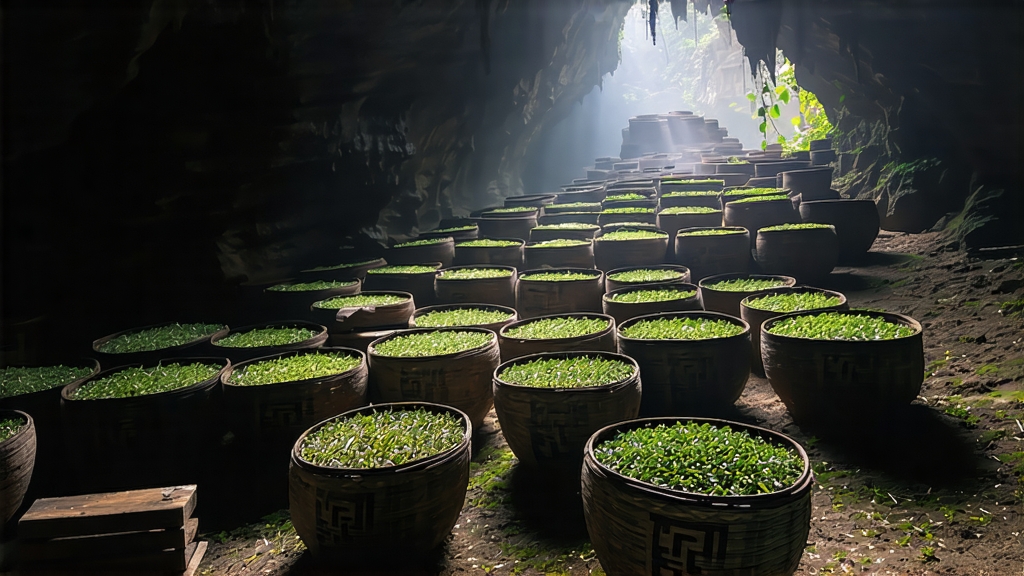
Liu Bao—literally “Six Forts”—is the name of a small township in Wuzhou, Guangxi, but to dark-tea lovers it is shorthand for one of China’s oldest post-fermented teas. While Pu-erh grabs headlines, Liu Bao has been quietly mellowing in sub-tropical caves since the Qing dynasty, carrying the scent of betel nut, camphor and damp earth across four centuries and the South China Sea to diaspora tea tables in Kuala Lumpur and Singapore. This article invites the international reader to discover a tea whose history is stitched into the Maritime Silk Road, whose flavour is shaped by micro-organisms that prefer limestone caverns to climate-controlled warehouses, and whose gentle caffeine curve makes it the favourite nightcap of dockworkers and emperors alike.
-
From Ming Militia to Tea Caravan
In 1539 the Ming court stationed six military garrisons—liu bao—along the trade corridor that linked the Yao highlands to the Xun River. Soldiers were paid partly in compressed tea bricks that could be bartered for rice, salt and herbs. The bricks travelled south by porter and raft, gaining moisture and microbial hitch-hikers along the way. By the time they reached the port of Guangzhou they had darkened, softened and developed a sweet, medicinal liquor. Merchants noticed the change, duplicated the journey on purpose, and Liu Bao tea was born. In 1796 the Qing imperial household listed it as “medicinal border tea,” and by 1886 the British East India Company recorded 1,100 tonnes annually shipped to Hong Kong and onward to Southeast Asia where coolies drank it to prevent malaria and dysentery. -
One Leaf, Three Styles
Modern Liu Bao is classified by picking standard and finishing method rather than mountain name.- Special Grade (teji): one bud with two leaves, plucked before Qingming; light oxidation keeps a trace of floral top note.
- First Grade (yiji): one bud with three leaves, plucked before Grain Rain; the classic everyday style that balances sweetness and body.
- Third Grade (sanji): larger leaves harvested through early summer; higher polyphenol content gives the deep, tarry liquor beloved by Malaysian towkays who boil it with rock sugar for “kopi-tiam” service.
Within each grade the tea can be sold loose, basket-aged (the traditional 20–50 kg bamboo baskets), or brick-pressed for humid climates.
-
Crafting the Darkness
Liu Bao shares the “kill-green, rolling, sun-drying” triad of green tea, but then enters a microbial rollercoaster unique among dark teas.
Step 1: Primary Fixation
Leaves are pan-fired at 280 °C for four minutes to arrest oxidative enzymes while preserving thermotolerant yeasts.
Step 2: Rolling & Pile-oxidation
A 30-minute machine roll ruptures 65 % of cell walls; the leaf is then piled 40 cm deep and covered with wet jute sacks. Internal temperature climbs to 55 °C within six hours; workers turn the pile every 45 minutes for 12–18 hours until a chestnut-brown colour and sticky texture emerge.
Step 3: Sun-drying
The semi-fermented leaf is spread on bamboo mats under subtropical sun for six hours, dropping moisture to 14 %.
Step 4: Steam-softening & Basket Pressing
A 30-second steam bath makes the leaf pliable enough to be tamped into double-layered bamboo baskets lined with untreated banana leaf. The baskets are stacked in ventilated sheds for three months, then moved to natural limestone caves where relative humidity hovers at 88 % and temperature at 22 °C year-round. Here the second, slower fermentation begins: Eurotium cristatum (the same “golden flower” fungus prized in Fu brick) blooms, converting catechins into theabrownins and gallic acid, while Geotrichum candidum produces the signature betel-nut aroma. After a minimum of three years the tea is considered market-ready; connoisseurs cellar it for decades. -
Brewing the Cavern Cup
Western writers often treat dark tea as a Pu-erh satellite, but Liu Bao demands its own parameters.
Water: 100 °C soft water (TDS 40–80 ppm); hard water dulls the camphor note.
Leaf ratio: 1 g per 15 ml for gongfu, 1 g per 100 ml for grandpa